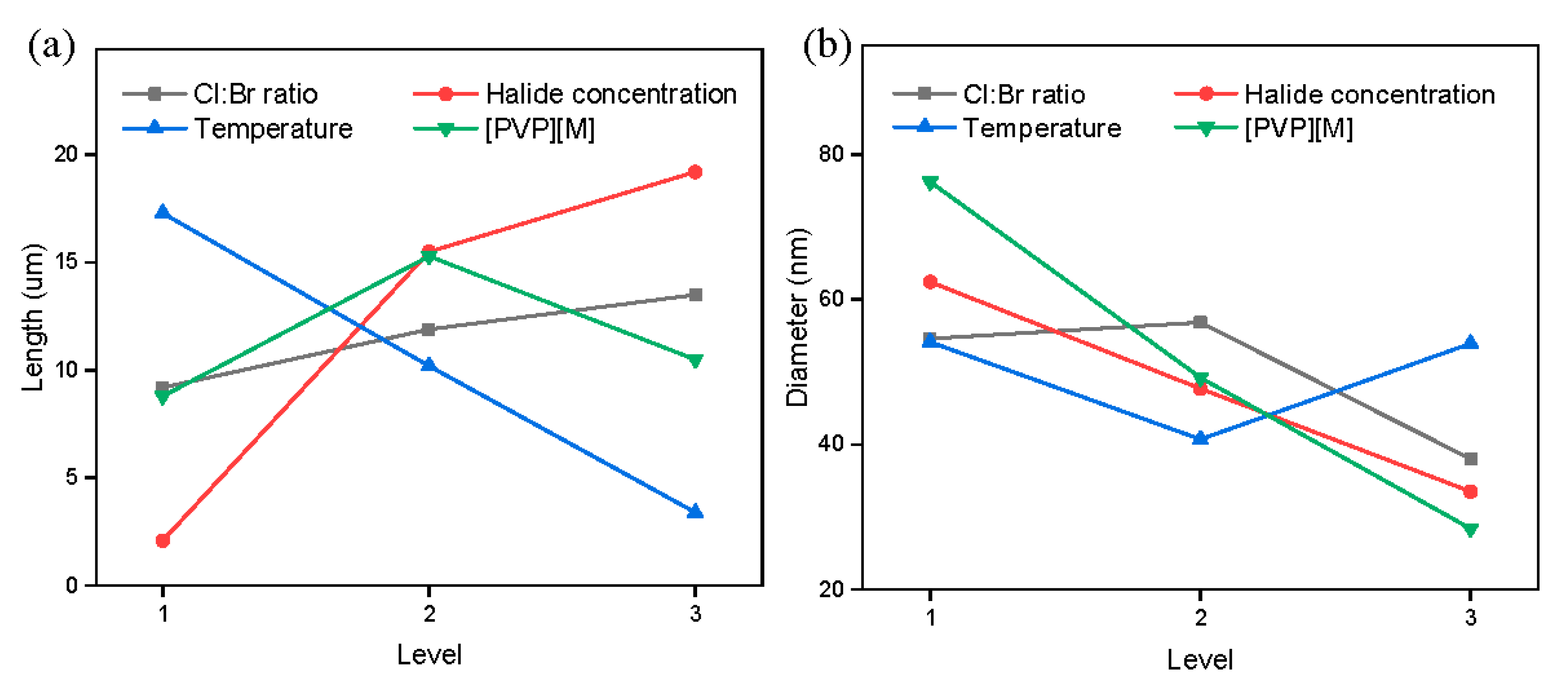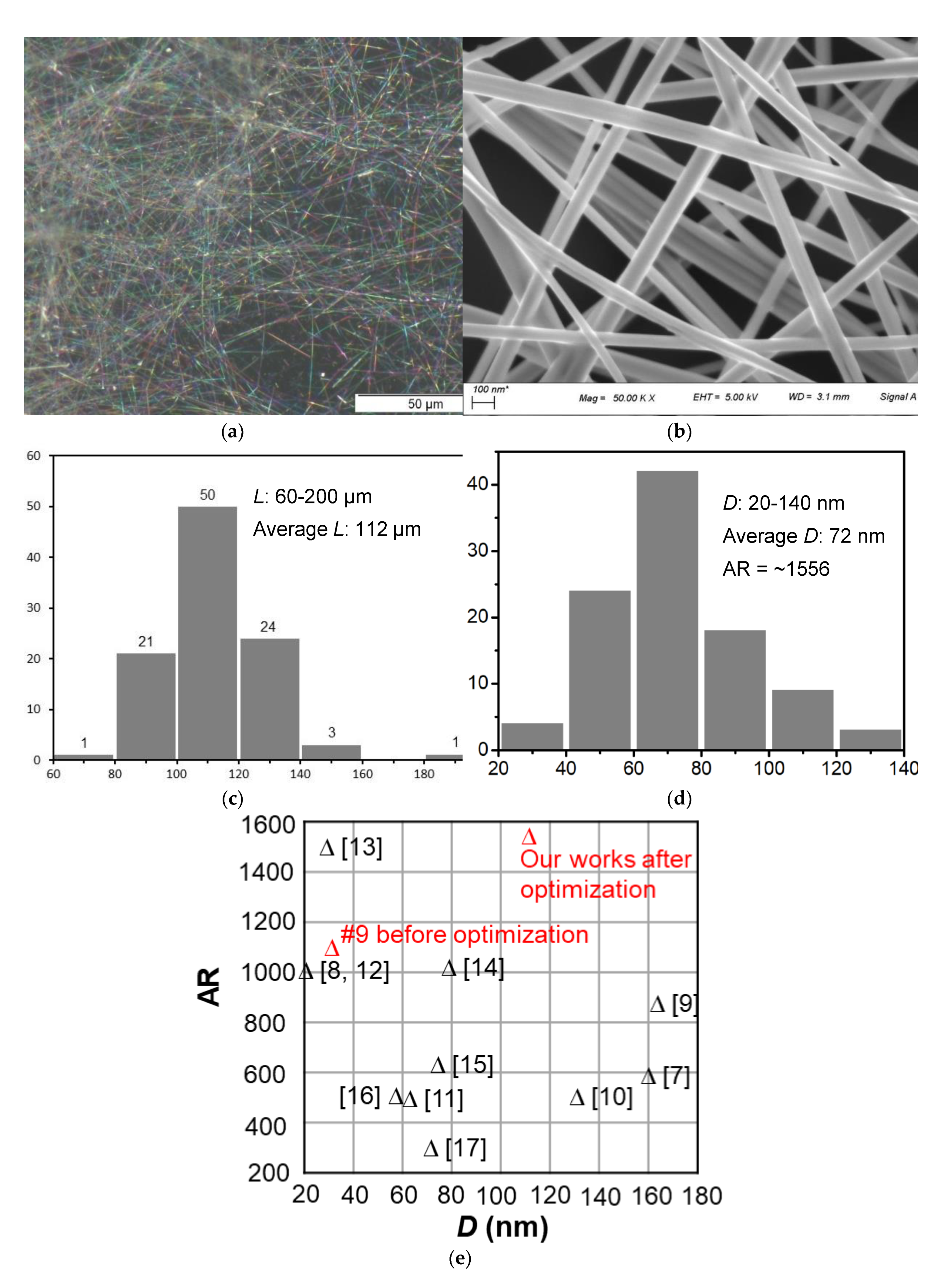Highly Stretchable and Kirigami-Structured Strain Sensors with Long Silver Nanowires of High Aspect Ratio
Abstract
:1. Introduction
2. Experiments
2.1. Materials
2.2. Taguchi Design of Experiment
2.3. Synthesis and Characterizations of AgNWs
2.4. Fabrication of Kirigami Strain Sensor
3. Results and Analysis
4. Conclusions
Author Contributions
Funding
Institutional Review Board Statement
Informed Consent Statement
Data Availability Statement
Conflicts of Interest
References
- Amjadi, M.; Kyung, K.-U.; Park, I.; Sitti, M. Stretchable, skin-mountable, and wearable strain sensors and their potential applications: A review. Adv. Funct. Mater. 2016, 26, 1678–1698. [Google Scholar] [CrossRef]
- Pegan, J.D.; Zhang, J.; Chu, M.; Nguyen, T.; Park, S.-J.; Paul, A.; Kim, J.; Bachman, M.; Khine, M. Skin-mountable stretch sensor for wearable health monitoring. Nanoscale 2016, 8, 17295–17303. [Google Scholar] [CrossRef] [PubMed]
- Xi, W.; Yeo, J.C.; Yu, L.; Zhang, S.; Lim, C.T. Ultrathin and wearable microtubular epidermal sensor for real-time physiological pulse monitoring. Adv. Mater. Technol. 2017, 2, 1700016. [Google Scholar] [CrossRef]
- Li, X.; Zhang, R.; Yu, W.; Wang, K.; Wei, J.; Wu, D.; Cao, A.; Li, Z.; Cheng, Y.; Zheng, Q.; et al. Stretchable and highly sensitive graphene-on-polymer strain sensors. Sci. Rep. 2012, 2. [Google Scholar] [CrossRef] [PubMed] [Green Version]
- Hempel, M.; Nezich, D.; Kong, J.; Hofmann, M. A novel class of strain gauges based on layered percolative films of 2D materials. Nano Lett. 2012, 12, 5714–5718. [Google Scholar] [CrossRef] [PubMed]
- Zhang, K.; Du, Y.; Chen, S. Sub 30 nm silver nanowire synthesized using KBr as co-nucleant through one-pot polyol method for optoelectronic applications. Org. Electron. 2015, 26, 380–385. [Google Scholar] [CrossRef]
- Mutiso, R.M.; Sherrott, M.C.; Rathmell, A.R.; Wiley, B.; Winey, K.I. Integrating simulations and experiments to predict sheet resistance and optical transmittance in nanowire films for transparent conductors. ACS Nano 2013, 7, 7654–7663. [Google Scholar] [CrossRef] [PubMed]
- Krantz, J.; Stubhan, T.; Richter, M.; Spallek, S.; Litzov, I.; Matt, G.J.; Spiecker, E.; Brabec, C.J. Spray-coated silver nanowires as top electrode layer in semitransparent P3HT:PCBM-based organic solar cell devices. Adv. Funct. Mater. 2012, 23, 1711–1717. [Google Scholar] [CrossRef]
- Amjadi, M.; Pichitpajongkit, A.; Lee, S.; Ryu, S.; Park, I. Highly stretchable and sensitive strain sensor based on silver nanowire–elastomer nanocomposite. ACS Nano 2014, 8, 5154–5163. [Google Scholar] [CrossRef] [PubMed]
- Sun, R.; Zhang, B.; Yang, L.; Zhang, W.; Farrow, I.; Scarpa, F.; Rossiter, J. Kirigami stretchable strain sensors with enhanced piezoelectricity induced by topological electrodes. Appl. Phys. Lett. 2018, 112, 251904. [Google Scholar] [CrossRef]
- Lamoureux, A.; Lee, K.; Shlian, M.; Forrest, S.R.; Shtein, M. Dynamic kirigami structures for integrated solar tracking. Nat. Commun. 2015, 6. [Google Scholar] [CrossRef] [PubMed]
- Hwang, D.-G.; Trent, K.; Bartlett, M.D. Kirigami-inspired structures for smart adhesion. ACS Appl. Mater. Interfaces 2018, 10, 6747–6754. [Google Scholar] [CrossRef] [PubMed]
- Morikawa, Y.; Yamagiwa, S.; Sawahata, H.; Numano, R.; Koida, K.; Ishida, M.; Kawano, T. Flexible devices: Ultrastretchable kirigami bioprobes. Adv. Heal. Mater. 2018, 7, 1870017. [Google Scholar] [CrossRef] [Green Version]
- Zhang, Y.; Yan, Z.; Nan, K.; Xiao, D.; Liu, Y.; Luan, H.; Fu, H.; Wang, X.; Yang, Q.; Wang, J.; et al. A mechanically driven form of Kirigami as a route to 3D mesostructures in micro/nanomembranes. Proc. Natl. Acad. Sci. USA 2015, 112, 11757–11764. [Google Scholar] [CrossRef] [Green Version]
- Xu, K.; Lu, Y.; Honda, S.; Arie, T.; Akita, S.; Takei, K. Highly stable kirigami-structured stretchable strain sensors for perdurable wearable electronics. J. Mater. Chem. C 2019, 7, 9609–9617. [Google Scholar] [CrossRef]
- Guan, Y.-S.; Zhang, Z.; Tang, Y.; Yin, J.; Ren, S. Kirigami-inspired nanoconfined polymer conducting nanosheets with 2000% stretchability. Adv. Mater. 2018, 30, e1706390. [Google Scholar] [CrossRef] [PubMed]
- Yong, K.; De, S.; Hsieh, E.Y.; Leem, J.; Aluru, N.; Nam, S. Kirigami-inspired strain-insensitive sensors based on atomically-thin materials. Mater. Today 2019, 34, 58–65. [Google Scholar] [CrossRef]
- Sun, Y.; Yin, Y.; Mayers, B.T.; Herricks, T.; Xia, Y. Uniform silver nanowires synthesis by reducing AgNO3 with ethylene glycol in the presence of seeds and Poly(Vinyl Pyrrolidone). Chem. Mater. 2002, 14, 4736–4745. [Google Scholar] [CrossRef]
- Yamada, T.; Hayamizu, Y.; Yamamoto, Y.; Yomogida, Y.; Izadi-Najafabadi, A.; Futaba, D.; Hata, K. A stretchable carbon nanotube strain sensor for human-motion detection. Nat. Nanotechnol. 2011, 6, 296–301. [Google Scholar] [CrossRef] [PubMed]
- Jinhwan, L.; Lee, P.; Lee, H.; Lee, D.; Lee, S.S.; Ko, S.H. Very long Ag nanowire synthesis and its application in a highly transparent, conductive and flexible metal electrode touch panel. Nanoscale 2012, 4, 6408–6414. [Google Scholar]





| Factors | Level 1 | Level 2 | Level 3 |
|---|---|---|---|
| Cl−:Br− molar ratio | 1:3 | 1:1 | 3:1 |
| Total Halide concentration [Cl− + Br−], mM | 0.3 | 0.6 | 1.2 |
| PVP concentration [PVP], M | 0.04 | 0.07 | 0.1 |
| Temperature (°C) | 140 | 150 | 160 |
| Experiment No. | Cl−:Br−Molar Ratio | Halide Concentration: [Cl− + Br−] (mM) | PVP Concentration: [PVP] (M) | Temperature (°C) | AgNW Diameter, D (nm) | AgNW Length, L (μm) |
|---|---|---|---|---|---|---|
| #1 | 1:3 | 0.3 | 0.04 | 140 | 97.3 | 0 |
| #2 | 1:3 | 0.6 | 0.07 | 150 | 44.1 | 16.3 |
| #3 | 1:3 | 1.2 | 0.10 | 160 | 22.3 | 10.9 |
| #4 | 1:1 | 0.3 | 0.10 | 150 | 71.9 | 0 |
| #5 | 1:1 | 0.6 | 0.04 | 160 | 36.4 | 20.7 |
| #6 | 1:1 | 1.2 | 0.07 | 140 | 62.1 | 15.7 |
| #7 | 3:1 | 0.3 | 0.07 | 160 | 19.3 | 0 |
| #8 | 3:1 | 0.6 | 0.10 | 140 | 69.1 | 10.7 |
| #9 | 3:1 | 1.2 | 0.04 | 150 | 28.7 | 29.5 |
Publisher’s Note: MDPI stays neutral with regard to jurisdictional claims in published maps and institutional affiliations. |
© 2021 by the authors. Licensee MDPI, Basel, Switzerland. This article is an open access article distributed under the terms and conditions of the Creative Commons Attribution (CC BY) license (https://creativecommons.org/licenses/by/4.0/).
Share and Cite
Huang, H.; Cai, C.J.; Yeow, B.S.; Ouyang, J.; Ren, H. Highly Stretchable and Kirigami-Structured Strain Sensors with Long Silver Nanowires of High Aspect Ratio. Machines 2021, 9, 186. https://doi.org/10.3390/machines9090186
Huang H, Cai CJ, Yeow BS, Ouyang J, Ren H. Highly Stretchable and Kirigami-Structured Strain Sensors with Long Silver Nanowires of High Aspect Ratio. Machines. 2021; 9(9):186. https://doi.org/10.3390/machines9090186
Chicago/Turabian StyleHuang, Huiyan, Catherine Jiayi Cai, Bok Seng Yeow, Jianyong Ouyang, and Hongliang Ren. 2021. "Highly Stretchable and Kirigami-Structured Strain Sensors with Long Silver Nanowires of High Aspect Ratio" Machines 9, no. 9: 186. https://doi.org/10.3390/machines9090186






